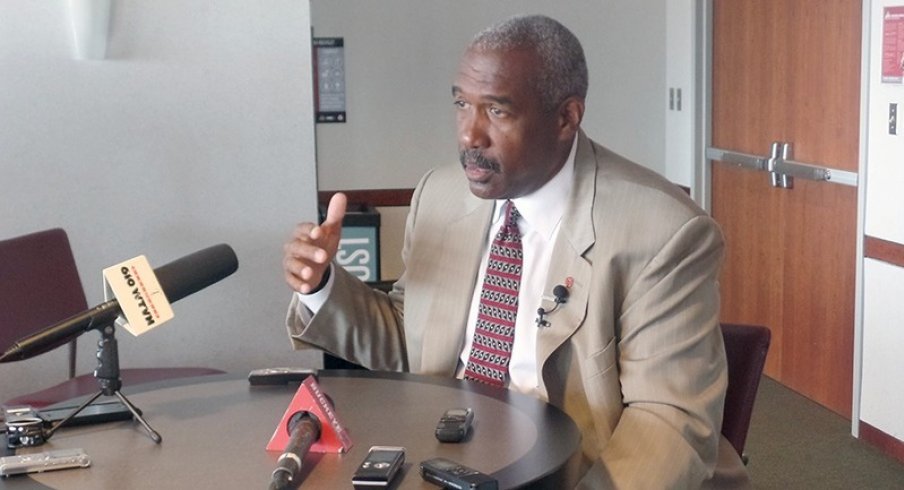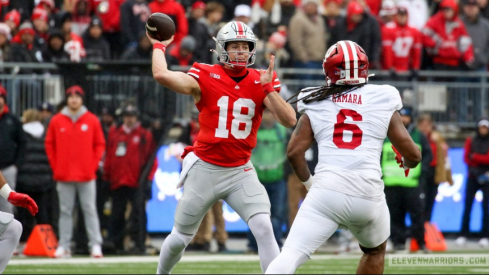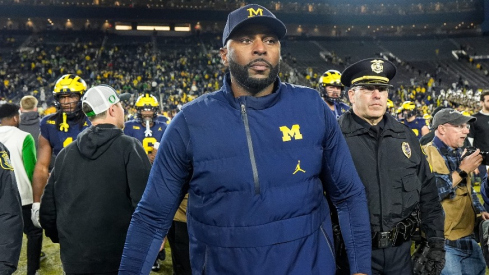Ohio State Director of Athletics and Vice President Gene Smith's been around the block a few times. He's seen the seemingly continuous changes evident across collegiate athletics, resulting from adaptations to technology, human interest and, lately, student-athlete benefits.
Smith and Ohio State took another step away from the idealism of amateur athletics Friday, when they announced beer and wine would be part of gameday menus in the suites and club level seating as part of a pilot program at Ohio Stadium this fall.
"The idea of trying a pilot program really came more from studying what other schools are doing," Smith said Friday. "(Director of Operations at University Registrar) Jack Miner, who heads our subcommittee for the athletic council, we're excited to have his leadership to look at what other schools are doing and then if we ultimately did anything here what would it look like. This kind of fits into that."
Smith noted Friday Ohio State will evaluate the possibility of keeping alcohol sales around for the future — and even extending them to the general admission seating — once the 2015 football season is completed.
"We have expenditures that are commitments for a lot of different areas. When the meal legislation came on board, when the cost of attendance came on board, we had to think differently about those commitments but also think about how we could generate more revenue."– Gene Smith
Ohio Stadium hosted concerts for The Rolling Stones, One Direction as well as a two-day Country Music Fest this summer where patrons purchased beer and wine. Alcohol's been available at the Schottenstein Center for men's and women's basketball and hockey games in club seats and suites since it's 1998 inception.
It's been around, but Smith is curious to see what it can do on a larger scale for football games — but not yet anything past what was announced Friday.
"I don't think we're ready to be outside," Smith said. "We're unique. We're 108,000 seats, unlike Maryland, unlike the other schools that are doing it. Every public school in the state of Ohio does it — Toledo's been doing it for years. But they're slightly different demographics, slightly different logistics."
Ohio State led the country in attendance last year, a result of multiple things. The football program at the University of Michigan — which plays in the largest stadium in the country — is down, and Ohio Stadium got an additional 2,522 seats prior to its 2014 national championship season.
Smith though, admitted there is a direct correlation between the need for additional revenue as a result of things like cost of attendance, student-athlete stipends and unlimited meal tickets for athletes.
"We have expenditures that are commitments for a lot of different areas," Smith said. "When the meal legislation came on board, when the cost of attendance came on board, we had to think differently about those commitments but also think about how we could generate more revenue."
Some might think that shouldn't be an issue for a place like Ohio State — which houses one of the largest athletic departments in the country — but providing money elsewhere cuts into the school's earnings pool. Size doesn't matter.
"We're trying to move toward variable ticket pricing and we dropped from $79 to $65 for two games. Do the math on that, that's a big number," Smith said. "So we took a hit on that intentionally to try and be more customer service oriented. Because of those things, we have to think about what other revenue streams can we create."
The data resulting from the pilot program is set to be evaluated upon season's end and a determination for the future will get announced "sometime next year."
Smith is unaware of the types of beer and wine that will be available for patrons on the suite and club levels and how much each drink will cost, but is confident the options will remain local.
"We haven't even gone that far yet. We know that if we end up doing something (in the future) we'll go local because we do it in the suites," Smith said. "It's important to make sure we do what we need to do in Ohio."
It's a big commitment for any school, particularly one as massive as Ohio State, but is another jump away from the amateurism model the NCAA's been trying to keep in place.
"They still are amateurs, but the old model, the way we think about it is different. Ohio State is a perfect example of that," Smith said. "We have 81 suites now, they're sold out. Every Big Ten game is sold out. That's gone a little bit."
Other news and updates from Smith Friday not having to do with alcohol sales:
- Smith jokingly said, "I do not know who the starting quarterback's going to be" before getting asked a question outside the realm of wine and beer sales.
- On the cost of attendance affecting recruiting, where some schools could use it as a tool against others if they're able to offer athletes more money, Smith said: "We knew that that would happen. We tried to create a level playing field. If you remember the original proposal was $2,000 across the board and legally we could not do that. So that's why we ended up where we were." He also added the exact number at Ohio State's been determined, but could not provide it.
- On the rumors swirling about the football team wearing black uniforms for its home game against Penn State Oct. 17, Smith just said "next question. I like that publicity. Keep it going."
- Ohio State is only selling jersey No. 1 (Braxton Miller) and No. 15 (Ezekiel Elliott) to the general public this year. How did that happen? "We made a conscious decision on that. I thought it was accurate and we made a conscious decision we needed to shift because of what was going on and we got lucky with the policy of using No. 1 and the years. We got 15 and 16 (coming) — got lucky."
- On the "conundrum" surrounding college football attendance being low, but television deals driving revenue shares: "The reality is you're trying to improve the television which could drive some fans there. I think for us, we should be able to overcome it ... The old Marketing 101 in 1969, it's product, place and price. We should never forget that. That's why we're constantly looking at our product, our team, how they behave, winning, the product, now we're looking at pricing."
- On Michigan coach Jim Harbaugh denying an interview request from the Big Ten Network bus tour this week, Smith deferred to respond, answering that he didn't know that happened and is unsure of the policy in place for such situations.
- On ex-Minnesota Athletic Director Norwood Teague, who resigned amid a scandal over drunken and inappropriate text messages sent at a work function: "Surprised and disappointed, obviously. There's no place for that behavior in any environment, so I was really shocked and disappointed and felt really painful for the victims." Smith added Ohio State has a "Lessons Learned" program in place among the administration to help prevent such circumstances from happening.


